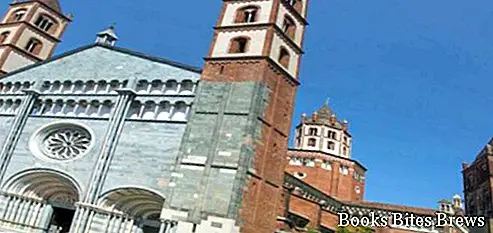What to see in Vercelli, itinerary including the main monuments and places of interest, including the Basilica of Sant'Andrea, the Cathedral and the Burgundy Museum.
Tourist information
City of Piedmont located on the right bank of the Sesia river, Vercelli is immersed in the typical landscape of rice fields which, in this part of the Po valley, extend into the fields among long rows of poplars.
The first settlements in the area, of which today only a few ceramic finds remain, date back to the Gallic population of Libui and the Ligurian one of Salii.
The Roman city, which was formed and developed from an urbanistic point of view especially with the beginning of the imperial age, was gradually incorporated into the Medieval city, enclosed by a new and wider city wall, which was demolished in 1704 by the French and replaced with the tree-lined avenues of the ring road.
Around Piazza Cavour, characterized by cobblestone pavement and medieval arcades, the valuable historic center is gathered, full of beautiful architecture and art.
The best-known monument in the city is the Basilica of Sant'Andrea, a beautiful architecture harmoniously built in Romanesque and Gothic styles between 1219 and 1227, at the behest of Cardinal Guala Bicchieri.
The Cathedral of Sant 'Eusebio has a neoclassical aspect, although its origins date back to a modest construction commissioned by Sant' Eusebio, rebuilt in the medieval period and remodeled between the second half of the sixteenth century until the eighteenth.
Near the Cathedral, the architectural complex of the Archbishop's Palace houses the Archive, the Chapter Library and the Museum of the Cathedral Treasury.
In the Library there is one of the oldest texts written in ancient English, the Vercelli Book, a parchment manuscript dating back to the end of the tenth century.
What see
The Church of San Cristoforo, whose structure dating back to the sixteenth century has been modified several times during the eighteenth century, preserves a heritage of pictorial works of the sixteenth century of great artistic value.
On Piazza Amedeo IX stands the Visconteo Castle, built by Matteo Visconti at the end of the thirteenth century and also inhabited by the Savoys.
Recommended readings- Alessandria (Piedmont): what to see in 1 day
- Langhe (Piedmont): what to see among castles, villages and vines
- Piedmont: Sunday day trips
- Oropa (Piedmont): what to see
- Cherasco (Piedmont): what to see
The Arca Museum is located in the former Church of San Marco, an exhibition space where prestigious exhibitions are hosted during the year, in addition to the Guggenheim exhibitions organized by the Piedmont Region and the Municipality, in collaboration with the Peggy Guggenheim Collection in Venice .
The Museo Borgogna is housed in a remarkable building in the historic center, built by the will of Antonio Borgogna, benefactor and art lover, belonging to the upper middle class of Vercelli, who in 1882 bought the palace and destined it to host his extraordinary art collection , including works ranging from the Renaissance to the nineteenth century, donated together with the Palazzo, to the city of Vercelli.
The Leone Museum is located in the rooms that the notary Camillo Leone donated to the Institute of Fine Arts.
This museum, inaugurated in 1910, shows an insight into the history of the city, from prehistory to the modern age, with a part of finds from the private collection of the notary Camillo Leone.




